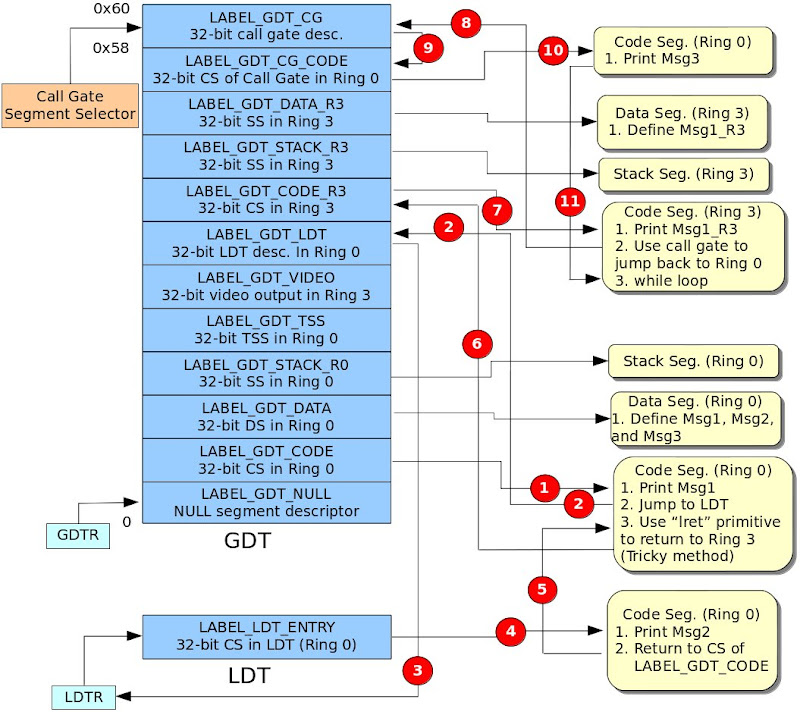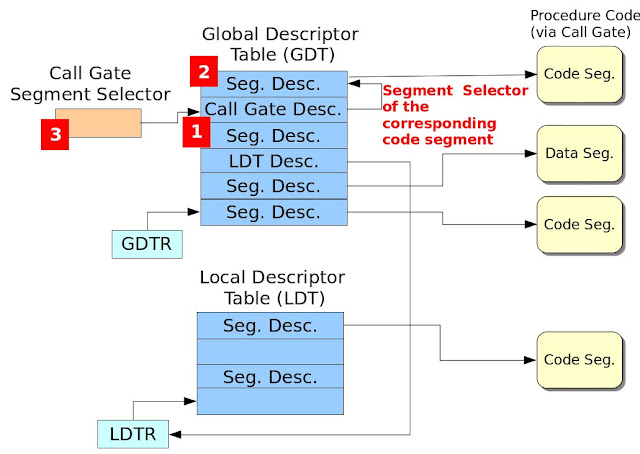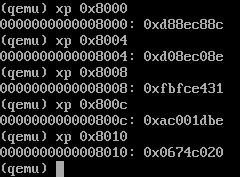前三篇文章所展示的程式碼都是CPU執行於真實模式 (Real Mode)。然而,一般作業系統運行於保護模式 (Protect Mode),其記憶體定址最高可至4GB (32位元)。故本文先介紹real mode與protect mode記憶體定址的方式。
Real mode與Protect mode記憶體定址介紹Figure 1展示real mode記憶體定址方式,其觀念在於將邏輯位址(Logical Address)的區段(Segment)位址向左位移4個位元,再將其所得的位址加上位移值,如此便能轉換成線性位址 (Linear Address)。至於,邏輯位址該如何表示呢? 其表示法為"Address of Segment:Offset"
,例如: CS:IP、SS:SP、DS:SI和ES:DI,詳情請參考x86 Assembly Language。Figure 1描述一個簡單邏輯位址轉換線性位址的例子,因此不再贅述。

Figure 1. Memory Segmentation in Real Mode
Figure 2展示保護模式記憶體定址方式,其觀念在於將區段 (Segment)看成區段選擇器 (Segment Selector),用此選擇器索引出對應的Segment Descriptor,如此便能索引32位元的基底位址 (32-bit base address),然後再加上位移植,便能轉換成線性位址。

Figure 2. Memory Segment in Protect Mode
保護模式相關課題之介紹 此段落將著重介紹保護模式相關課題之介紹,包含介紹GDT/LDT (GDTR/LDTR)、Segment Descriptor、Segment Selector、 和Memory Management Register
Global and Local Descriptor Table (GDT and LDT)
當CPU運行於保護模式時,所有的記憶體存取都必須經由GDT或LDT,此表格 (GDT or LDT)存放最小單元便是Segment Descriptor。每一個Segment Descriptor都有對應的segment selector,用以索引出對應的Segment Descriptor。
GDTR and LDTR (GDT Register and LDT Register)GDTR與LDTR用以儲存GDT與LDT的起始位置,此設定必須在進入保護模式完成設定。Figure 3展示GDTR與LDTR格式,其中GDTR包含32位元的基底位址與16位元的長度限制。而LDTR多增加了16位元的segment selector。

Figure 3. Memory Management Register
Segment DescriptorSegment Descriptor為Descriptor Table組成的基本元素,其長度為8位元組。如Figure 4所示,可分為三大類: 1. 32位元的基底位址 (Base Address), 2. 20位元的區段限制 (Segment Limit), 3. 區段屬性。細節請參考
Intel 64 and IA-32 Architectures. Software Developer's Manual. Volume 3A
Figure 4. Segment Descriptor [2]
Segment SelectorFigure 5展示Segment Selector示意圖,其目的用來索引對應的Segment Descriptor。因Descriptor Index有13個位元,故Descriptor個數最大可至8192。

Figure 5. Segment Selector
Boot Loader程式碼/* boot_loader.S
*
* Copyright (C) 2010 Adrian Huang (adrianhuang0701@gmail.com)
*
* This code is intended to simulate a simplified boot loader. This boot
* loader loads 3 sectors into the physical memory and jumps the entry
* point of OS.
*
*/
.code16
.text
.set BOOT_SEG, 0x07C0 /* starting code segment (CS) of boot loader */
.set OS_SEG, 0x0900 /* code segment address of OS entry point */
.set OS_OFFSET, 0x0000 /* the offset address of OS entry point */
.global _start
_start:
# FAT12 file system format
jmp start_prog # jmp instruction
.byte 0x90
.ascii "ADRIAN " # OEM name (8 bytes)
.word 512 # Bytes per sector
.byte 1 # Sector per cluster
.word 1 # Reserved sector count: should be 1 for FAT12
.byte 2 # Number of file allocation tables.
.word 224 # Maximum number of root directory entries.
.word 2880 # Total sectors
.byte 0xf0 # Media descriptor:
.word 9 # Sectors per File Allocation Table
.word 18 # Sectors per track
.word 2 # Number of heads
.long 0 # Count of hidden sectors
.long 0 # Total sectors
.byte 0 # Physical driver number
.byte 0 # Reserved
.byte 0x29 # Extended boot signature
.long 0x12345678 # Serial Number
.ascii "HELLO-OS " # Volume Label
.ascii "FAT12 " # FAT file system type
.fill 18, 1, 0 # fill 18 characters with zero
start_prog:
# initialize the register with cs register
movw %cs, %ax
movw %ax, %ds
movw %ax, %es
movw %ax, %ss
xorw %sp, %sp
cld # clear direction flag
sti # set interrupt flag
# The following code is loaded three sectors (2-4th sectors from boot.bin)
# into the physical memory 0x8000-0x85FF.
movw $OS_SEG, %ax
mov %ax, %es # ES:BX-> destination buffer address pointer
movw $OS_OFFSET, %bx
movb $2, %cl # sector
cont:
movb $0x02, %ah # Read sectors from drive
movb $0x1, %al # Sectors to read count
movb $0x0, %ch # track
movb $0x0, %dh # head
movb $0, %dl # drive
int $0x13 # trigger a interrupt 0x13 service
jc fail # the clear flag is set if the operation is failed
mov %es, %ax
addw $0x20, %ax # move to the next sector
movw %ax, %es # move to the next sector
incb %cl
cmpb $3, %cl # has finished reading 3 sectors?
jbe cont # continue to read the sector
jmp os_entry # jump to OS entry point
fail:
movw $err_msg, %si
fail_loop:
lodsb
andb %al, %al
jz end
movb $0x0e, %ah
int $0x10
jmp fail_loop
os_entry:
ljmp $OS_SEG, $OS_OFFSET # jump to os context
end:
hlt
jmp end
err_msg:
.ascii "Reading sectors operation is failed!"
.byte 0
.org 0x1FE, 0x41 # fill the rest of characters with zero until the 254th character
# Boot sector signature
.byte 0x55
.byte 0xaa
作業系統程式碼此作業系統程式碼運行於32位元保護模式,一開始定義三個Segment Descriptor (NULL, CODE32與VIDEO),其中VIDEO的基底位址為0xB8000,詳情請參考
Printing to Screen。接著定義GDT的長度、定義Code32與VIDEO的segment selector、定義GDTPtr。
16位元real mode程式碼 (os_main)中,執行若干任務如下所述:
- 設定Code32的基底位址為PE_CODE32的起始位址
- 設定GDTPtr的基底位址為GDT的起始位址(也就是GDT_DESC_NULL)
- 開啟A20線路 (A20 Line)
- 將GDT的起始位址載入至GDTR暫存器
- 設定cr0暫存器的bit 0以便進入保護模式
- 使用ljmp指令跳至PE_CODE32程式碼
32位元保護模式程式碼 (PE_CODE32)利用Video segment selector將'H'字元顯示在螢幕,用以驗證程式運作之正確性。
/* os.S
*
* Adrian Huang (adrianhuang0701@gmail.com)
*
* This code is OS context for protected-mode.
*
*/
#include "pm.h"
.code16
.text
jmp os_main
# Segment descritors for GDT
GDT_DESC_NULL: SEG_DESC 0, 0, 0
GDT_DESC_CODE32: SEG_DESC 0, (PECode32Len - 1), (DESC_ATTR_TYPE_CD_ER | DESC_ATTR_D)
GDT_DESC_VIDEO: SEG_DESC 0xB8000, 0xFFFF, (DESC_ATTR_TYPE_CD_RW)
# The length of GDT
.set GdtLen, (. - GDT_DESC_NULL)
# Segment selectors for code segment and video output
.set SegSelectorCode32, (GDT_DESC_CODE32 - GDT_DESC_NULL)
.set SegSelectorVideo, (GDT_DESC_VIDEO - GDT_DESC_NULL)
# GDTR pointer
GDTPtr:
.2byte (GdtLen - 1) # Limit field
.4byte 0 # base field
# real-mode OS code
os_main:
mov %cs, %ax
mov %ax, %ds
mov %ax, %ss
mov %ax, %es
/* Set gdt for code segment */
InitSegDescriptor PE_CODE32, GDT_DESC_CODE32
/* Set GDTR */
xor %ax, %ax
mov %cs, %ax
shl $4, %eax
addl $GDT_DESC_NULL, %eax
movl %eax, (GDTPtr + 2)
/* Enable A20 line */
xor %ax, %ax
in $0x92, %al
or $2, %al
out %al, $0x92
cli
/* Load the GDT base address and limit from memory into the GDTR register */
lgdt GDTPtr
/* Enable protect mode */
movl %cr0, %eax
orl $1, %eax
movl %eax, %cr0
/* Jump to protected-mode OS code */
ljmp $SegSelectorCode32, $0
# protected-mode OS code
PE_CODE32:
.code32
/* Load Video segment selector */
mov $(SegSelectorVideo), %ax
mov %ax, %gs
/* Output the data */
movl $((80 * 10 + 0) * 2), %edi
movb $0xC, %ah
movb $'H', %al
mov %ax, %gs:(%edi)
jmp .
.set PECode32Len, (. - PE_CODE32)
os_msg:
.ascii "Welcome to OS context!"
.byte 0
.org 0x200, 0x41 # fill characters with 'A'. Sector 2
pm.h標頭檔/* pm.h
*
* Adrian Huang (adrianhuang0701@gmail.com)
*/
.macro SEG_DESC Base, Limit, Attr
.2byte (\Limit & 0xFFFF)
.2byte (\Base & 0xFFFF)
.byte ((\Base >> 16) & 0xFF)
.2byte ((\Attr & 0xF0FF) | ((\Limit >> 8) & 0x0F00))
.byte ((\Base >> 24) & 0xFF)
.endm
.macro InitSegDescriptor OFFSET GDT_SEG_ADDR
xor %ax, %ax
mov %cs, %ax
shl $4, %eax
addl $(\OFFSET), %eax
movw %ax, (\GDT_SEG_ADDR + 2)
shr $16, %eax
movb %al, (\GDT_SEG_ADDR + 4)
movb %ah, (\GDT_SEG_ADDR + 7)
.endm
.set DESC_ATTR_TYPE_LDT, 0x82 /* LDT Segment */
.set DESC_ATTR_TYPE_CD_ER, 0x9A /* Code segment with Execute/Read */
.set DESC_ATTR_TYPE_CD_E, 0x98 /* Code segment with Execute Only */
.set DESC_ATTR_TYPE_CD_RW, 0x92 /* Data segment with R/W */
.set DESC_ATTR_D, 0x4000 /* 32-bit segment */
/* Selector Attribute */
.set SA_TIL, 0x4
.set SA_RPL0, 0x0
.set SA_RPL1, 0x1
.set SA_RPL2, 0x2
.set SA_RPL3, 0x3
編譯程式碼下圖為編譯的Makefile。
LD=ld
CC=gcc
all: boot_loader.bin
boot_loader.bin: boot_loader.o os.o
${LD} -Ttext=0x7C00 -s $< -o $@ --oformat binary
${LD} -Ttext=0x0 -s os.o -o os.bin --oformat binary
cat os.bin >> $@
boot_loader.o:
${CC} -c boot_loader.S
os.o:
${CC} -c os.S
clean:
rm -f boot_loader.o os.o os.bin boot_loader.bin
其編譯訊息如下所示: adrian@adrian-desktop:~/working/build_os/my_ex/04day/pe-orig-makefile$ make all
gcc -c boot_loader.S
gcc -c os.S
ld -Ttext=0x7C00 -s boot_loader.o -o boot_loader.bin --oformat binary
ld -Ttext=0x0 -s os.o -o os.bin --oformat binary
ld: warning: cannot find entry symbol _start; defaulting to 0000000000000000
cat os.bin >> boot_loader.bin
QEMU測試結果
【Reference】
[1]
Solrex - 使用開源軟體-自己動手寫作業系統[2]
Intel 64 and IA-32 Architectures. Software Developer's Manual. Volume 3A[3]
30天打造OS!作業系統自作入門[4]
Jserv's Blog[5]
X86 開機流程小記[6]
Linux assemblers: A comparison of GAS and NASM[7] linux-source-2.6.31




































